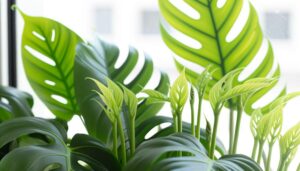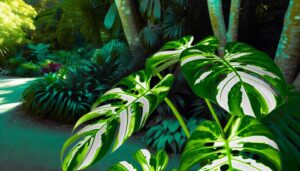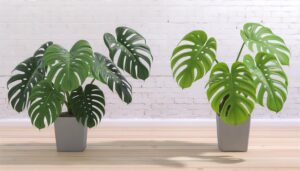Monstera Borsigiana Indoor Vs Outdoor Care
Taking care of Monstera Borsigiana indoors and outdoors involves distinct needs. Indoors, provide bright, indirect light, and maintain temperatures between 65-80°F.
Use a humidifier to maintain humidity at 60-80%, and water weekly, reducing in winter. Outdoors, place in filtered sunlight, guaranteeing warm, frost-free conditions.
The soil should be well-draining, rich in organic matter, and slightly acidic. Fertilize every 4-6 weeks during growth phases, and trim yellow leaves.
Monitor for pests like spider mites and mealybugs. With these tips, you'll ensure your Monstera thrives beautifully in both environments.
Curious about specific seasonal care and common issues?

Key Takeaways
- Monstera Borsigiana prefers bright, indirect light indoors and filtered sunlight outdoors.
- Maintain indoor temperatures between 65-80°F and ensure outdoor conditions are consistently warm and frost-free.
- Indoor humidity should be 60-80%, while outdoor watering needs to be adjusted during dry spells.
- Use well-draining soil rich in organic matter for both indoor and outdoor planting to prevent root rot.
- Regular pruning and pest inspections are essential for healthy growth in both environments.
Light Requirements
Securing that your Monstera Borsigiana receives bright, indirect light will promote ideal growth and health. Place it near an east or north-facing window where it can absorb filtered sunlight. Direct sunlight can scorch its leaves, causing brown spots and stunted growth. If natural light isn't abundant, consider using fluorescent or LED grow lights, which can mimic the sun's spectrum effectively.
Monitor the plant's response; elongated stems and smaller leaves indicate insufficient light. Conversely, pale or yellowing leaves can result from too much light. Adjust the light source accordingly. You'll want the light intensity to be around 10,000 to 20,000 lux.
Regularly rotate the plant to secure even light distribution, preventing it from leaning towards the light source. This balanced light exposure secures robust, symmetrical growth.
Temperature Preferences
When caring for your Monstera Borsigiana, it's important to maintain an indoor temperature range between 65-80°F (18-27°C) for best growth.
These plants also tolerate outdoor conditions, provided the climate remains consistently warm and free from frost.
Make sure you monitor temperature fluctuations to prevent stress and promote healthy development.
Ideal Indoor Temperatures
For ideal growth, Monstera Borsigiana thrives in indoor temperatures ranging between 65°F and 85°F, maintaining it remains healthy and vibrant year-round. You should sustain a stable temperature within this range, as fluctuations can stress the plant. Avoid placing your Monstera near cold drafts or heat sources like radiators, which can create temperature extremes detrimental to its development.
Humidity is also essential; aim for levels between 60-80%. If your indoor environment is dry, consider using a humidifier or placing a water tray near the plant. Regularly monitor the temperature and humidity with a reliable gauge to ensure best conditions.
Outdoor Climate Tolerance
Monstera Borsigiana can tolerate outdoor temperatures between 65°F and 85°F but struggles in temperatures outside this range. When temperatures dip below 60°F, the plant's growth slows, and cold damage can occur. Conversely, temperatures above 90°F may cause leaf scorching and dehydration. Monitoring the climate is essential for outdoor cultivation.
| Temperature Range | Effect on Monstera Borsigiana |
|---|---|
| Below 60°F | Growth slows, cold damage |
| 60°F – 64°F | Minimal growth, potential stress |
| 65°F – 85°F | Best growth, healthy foliage |
| 86°F – 89°F | Mild stress, increased watering |
| Above 90°F | Leaf scorching, dehydration |
Always ensure your Monstera receives sufficient water and shade during hot spells, and consider moving it indoors during cold snaps.
Humidity Levels
To maximize your Monstera Borsigiana thrives, you'll need to maintain ideal indoor humidity levels between 60% and 80%.
Outdoor humidity can pose challenges, often requiring additional measures to balance moisture levels effectively.
Using a humidifier or placing the plant on a pebble tray can help maintain the necessary environment for peak growth.
Ideal Indoor Humidity
Achieving the best indoor humidity level of 60-70% is crucial for guaranteeing the Monstera Borsigiana thrives in your home environment. This tropical plant requires a consistently moist atmosphere to mimic its native habitat.
Use a hygrometer to monitor humidity levels accurately. If your indoor air is too dry, consider using a humidifier or placing a tray of water near the plant. Grouping plants can also enhance local humidity.
Guarantee proper air circulation to prevent fungal issues, which can arise in overly stagnant conditions. Avoid placing the plant near heat sources or air conditioners, as these can significantly reduce humidity levels.
Maintaining the ideal humidity will promote healthy growth, lush foliage, and overall essentiality in your Monstera Borsigiana.
Outdoor Humidity Challenges
While maintaining indoor humidity levels is manageable, outdoor humidity challenges can pose a different set of issues for your Monstera Borsigiana, particularly in areas with fluctuating weather conditions.
Outdoor environments can vary dramatically in humidity, especially between day and night. High humidity can lead to fungal growth and root rot, while low humidity may cause the leaves to dry out and brown at the edges. Additionally, wind can further reduce moisture levels, exacerbating the plant's stress.
Monitoring local weather forecasts and utilizing hygrometers can help you keep track of humidity levels. In extreme cases, consider temporary solutions like misting or using portable humidifiers to maintain an ideal environment for your Monstera Borsigiana outdoors.
Balancing Moisture Levels
Balancing moisture levels for your Monstera Borsigiana involves maintaining a consistent humidity range between 60% and 80% to prevent stress and promote healthy growth. To achieve this, use a hygrometer to monitor indoor humidity.
If levels are low, increase humidity by misting the leaves, placing the plant on a pebble tray with water, or using a humidifier. Avoid overwatering; make sure the soil is well-draining to prevent root rot.
Outdoors, humidity may naturally fluctuate more, so be attentive to weather changes. During dry spells, supplement with additional misting or move the plant to a more humid microenvironment.
Consistent humidity helps your Monstera thrive, leading to vibrant, fenestrated leaves and robust growth.
Watering Schedule
It's crucial to water your Monstera Borsigiana consistently, making sure the soil remains moderately moist but never waterlogged. Indoors, water approximately once a week, adjusting based on humidity levels and the season. During winter, when growth slows, reduce watering frequency.
Outdoors, monitor rainfall and supplement water during dry spells to prevent dehydration. Use your finger or a moisture meter to check soil moisture levels; the top inch should be dry before you water again. Overwatering can lead to root rot, so verify drainage is adequate. Conversely, underwatering can cause leaf wilting and browning.
Soil Conditions
To maximize growth for your Monstera Borsigiana, use a soil mix rich in organic matter and well-draining properties.
A combination of peat, perlite, and orchid bark works well to maintain moisture while preventing waterlogging.
Additionally, the soil should be nutrient-rich to support the plant's vigorous growth.
Optimal Soil Composition
Your Monstera Borsigiana thrives best in a well-draining, nutrient-rich soil mix that mimics its natural tropical habitat. Start with a base of high-quality potting soil, which provides essential nutrients.
To enhance drainage and aeration, incorporate perlite or pumice at about 20-30% of the mix. Adding orchid bark or coco coir helps retain moisture without waterlogging, essential for root health.
A handful of activated charcoal can prevent root rot by improving soil aeration and absorbing toxins. The ideal pH range for your Monstera Borsigiana is slightly acidic to neutral, around 5.5 to 7.
Keep the soil loose and airy to support root development and nutrient uptake, fostering a thriving, vibrant plant.
Drainage Requirements
Proper drainage is crucial for preventing waterlogged conditions that can lead to root rot in Monstera Borsigiana. When planting, select a pot with drainage holes and use a well-draining soil mix. A mix of perlite, orchid bark, and peat moss works well.
Indoors, make sure that water can freely exit the pot, avoiding saucers that retain water. Outdoors, plant in raised beds or mounds to enhance drainage. Avoid heavy, compacted soils that retain moisture.
Regularly check the soil's moisture levels by inserting your finger about an inch deep; it should feel dry before the next watering. By maintaining excellent drainage, you promote healthy root development and prevent fungal diseases, ensuring your Monstera Borsigiana thrives in both indoor and outdoor settings.
Nutrient Needs
Securing your Monstera Borsigiana receives the right balance of nutrients is crucial for its strong growth and vibrant foliage.
Indoors, you'll want to use a well-draining potting mix rich in organic matter, such as peat moss, perlite, and orchid bark. This blend guarantees aeration and retains essential nutrients.
For outdoor care, planting in slightly acidic, loamy soil that's enriched with compost will provide ideal conditions.
Regularly supplement with a balanced, water-soluble fertilizer, ideally with an NPK ratio of 20-20-20, diluted to half strength, every month during the growing season.
Monitor the plant for signs of nutrient deficiency, like yellowing leaves, and adjust feeding accordingly. Remember, over-fertilization can harm your Monstera, so moderation is crucial.
Fertilizing Needs
When fertilizing your Monstera Borsigiana, it's vital to use a balanced, water-soluble fertilizer to promote healthy growth and leaf development. Apply the fertilizer every 4-6 weeks during the growing season, which typically spans from spring to early autumn.
Choose a 20-20-20 NPK ratio, ensuring equal parts of nitrogen, phosphorus, and potassium. Dilute the fertilizer to half the recommended strength to prevent root burn. Indoor plants might need less frequent fertilization compared to outdoor ones due to slower growth rates.
Always water the plant before applying fertilizer to avoid concentrated nutrient exposure. Monitoring the plant's response is essential; yellowing leaves could indicate over-fertilization, while pale leaves might signal nutrient deficiency. Adjust accordingly for best health.
Pruning Techniques
Regular trimming of your Monstera Borsigiana not only helps maintain its shape but also encourages robust growth and prevents potential disease. Start by using sterilized trimming shears to cut back any yellowing or damaged leaves, making sure you're making clean cuts close to the main stem.
Target older, larger leaves first to allow more light to reach younger foliage. Trim aerial roots sparingly, as they're necessary for nutrient absorption. Always trim during the plant's active growing season, typically spring or early summer, to minimize stress.
Monitor your plant for signs of overgrowth, such as crowded leaves or stems, and trim as necessary to maintain airflow. Proper trimming techniques will guarantee your Monstera remains healthy and vibrant, both indoors and outdoors.
Pest Management
Fighting pests on your Monstera Borsigiana involves identifying common culprits like spider mites, aphids, and mealybugs, then using targeted treatments to eradicate them.
First, inspect your plant regularly, focusing on the undersides of leaves and new growth where pests tend to hide. For spider mites, use a miticide or insecticidal soap.
Aphids can be managed with a mixture of water and dish soap, sprayed directly on the affected areas. Mealybugs require a cotton swab dipped in rubbing alcohol, applied to each insect.
Guarantee proper air circulation and avoid over-watering, as these conditions promote pest infestations. Regularly clean your plant's leaves with a damp cloth to remove dust and potential pests.
Supporting Growth
To support the growth of your Monstera Borsigiana, make sure it receives bright, indirect light and maintain a consistent watering schedule that keeps the soil moist but not waterlogged.
Use well-draining soil enriched with organic matter to provide necessary nutrients. Guarantee the ambient temperature stays between 65°F and 85°F, as extreme temperatures can hinder growth.
High humidity levels, ideally between 60-80%, are essential for peak development. Regularly clean the leaves to maximize photosynthesis efficiency and prevent dust accumulation.
Provide a climbing structure, like a moss pole, to mimic its natural growth habit. Fertilize monthly during the growing season with a balanced, water-soluble fertilizer.
Seasonal Care
Adapting your Monstera Borsigiana care routine to the changing seasons guarantees the plant remains healthy and vibrant year-round. During spring and summer, make sure you:
- Increase Watering: Water more frequently, as the plant's growth rate accelerates.
- Enhance Lighting: Provide bright, indirect light to support photosynthesis.
- Boost Humidity: Use a humidifier or mist the leaves to maintain high humidity levels.
In autumn and winter, adjust care by:
- Reducing Watering: Decrease the frequency to prevent root rot, as growth slows.
- Maintaining Light: Keep the plant in a well-lit area, compensating for shorter daylight hours.
- Monitoring Temperature: Guarantee indoor temperatures remain between 65-75°F to avoid stress.
These adjustments optimize your Monstera Borsigiana's environment through seasonal changes.
Common Issues
As you adjust your care routine with the changing seasons, it's important to recognize and address common issues that can affect your Monstera Borsigiana's health.
Indoors, watch for root rot caused by overwatering; make sure your pot has good drainage. Yellowing leaves can indicate nutrient deficiencies or improper lighting.
Outdoors, pests like spider mites and aphids may attack, particularly in warmer months. Inspect the leaves regularly and use insecticidal soap if needed.
Both environments can lead to fungal infections if humidity is too high. Keep airflow around the plant and avoid overcrowding.
Additionally, cold drafts can damage your Monstera, so protect it from sudden temperature drops. By staying vigilant, you can maintain a thriving Monstera Borsigiana year-round.
Conclusion
When caring for your monstera borsigiana, remember to tailor its environment based on whether it's indoors or outdoors.
Monitor light, temperature, and humidity meticulously to promote growth. Keep a close eye on watering schedules and soil conditions, and be vigilant about pest management.
Supporting its growth through seasonal care will help prevent common issues. Think of it like tuning an old radio; with the right adjustments, you'll achieve harmony and watch your plant thrive.






